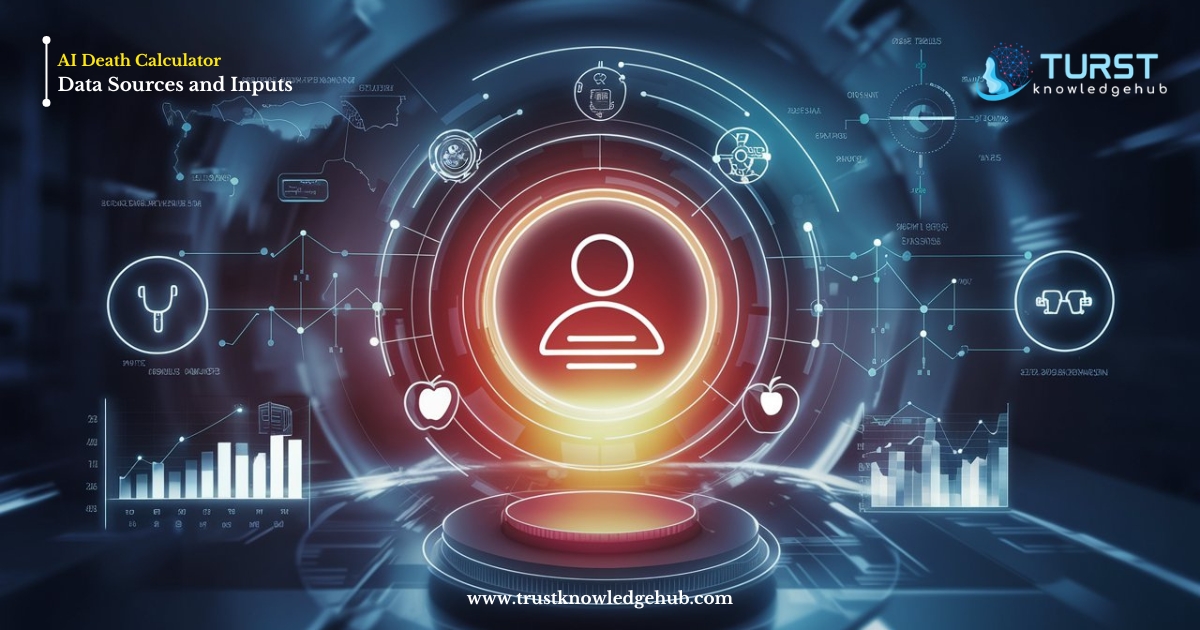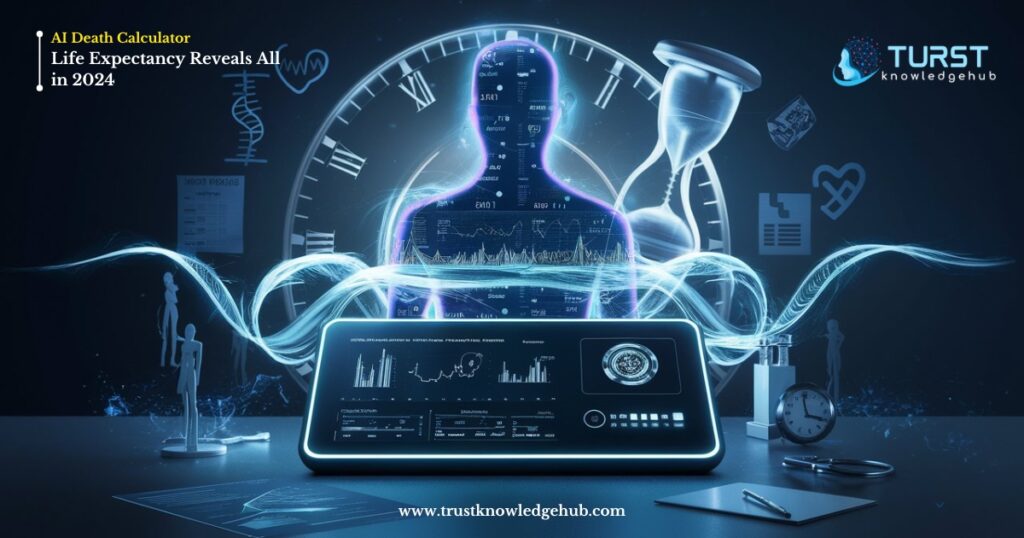This article aims to explore the functionality and implications of the Artificial Intelligence Death Calculator, detailing its underlying algorithms, ethical considerations, and potential impact on healthcare and longevity research, providing readers with a comprehensive understanding of this innovative tool.
Unveiling the Artificial Intelligence Death Calculator Phenomenon
In an era where artificial intelligence (AI) continuously reshapes our world, a new, intriguing innovation has emerged: the AI Death Calculator. This tool promises to predict an individual’s life expectancy with remarkable accuracy, raising both fascination and concern. As AI permeates various aspects of our lives, from virtual assistants to autonomous vehicles, the AI Death Calculator stands out as a particularly compelling application of this technology.
Why 2024 is the Year of Predictive Life Expectancy
The year 2024 marks a significant milestone in the field of predictive analytics, especially concerning life expectancy. With advancements in machine learning algorithms and the availability of vast datasets, the AI Death Calculator has reached a level of sophistication previously thought impossible. This breakthrough is not just a technological achievement but also a testament to our growing understanding of human health and longevity.
The Evolution of Life Expectancy Predictions
From Actuarial Tables to AI Algorithms
Historically, life expectancy predictions relied heavily on actuarial tables, which used statistical data to estimate the average lifespan based on various demographic factors. While useful, these tables were limited in their ability to account for individual differences. The advent of AI algorithms has revolutionized this process, allowing for highly personalized predictions that consider a multitude of variables unique to each person.
Historical Milestones in Predictive Analytics
Predictive analytics has undergone significant evolution from its early beginnings. Early efforts in the 20th century laid the groundwork for today’s sophisticated models. Milestones include the development of regression analysis, the introduction of machine learning in the 1990s, and the more recent explosion of big data analytics. Each step has brought us closer to the highly accurate predictions now made possible by tools like the AI Death Calculator.
Understanding the AI Death Calculator
Defining the AI Death Calculator
The AI Death Calculator is an advanced predictive tool designed to estimate an individual’s life expectancy. It uses complex algorithms to analyze vast amounts of data, including medical records, lifestyle choices, and genetic information. The goal is to provide a personalized prediction that is far more accurate than traditional methods.
The Science Behind Predicting Mortality
Predicting mortality involves understanding the myriad factors that contribute to life expectancy. These include biological markers, environmental influences, and behavioral patterns. The AI Death Calculator synthesizes this information using sophisticated machine-learning techniques to identify patterns and correlations that might be invisible to human analysts.
Core Technologies and Innovations
Machine Learning: The Brain Behind Predictions
Machine learning is at the heart of the Artificial Intelligence Death Calculator. By continuously learning from new data, these algorithms improve their accuracy over time. This iterative process allows the AI to refine its predictions and adapt to new insights, making it an ever-evolving tool.
Big Data: Fueling the AI Engine
Big data provides the fuel that powers the AI Death Calculator. The tool analyzes vast datasets encompassing millions of health records, genetic profiles, and lifestyle factors. This wealth of information enables the AI to identify trends and make predictions with a high degree of confidence.
Integrating Genetic Information
Genetic information plays a crucial role in predicting life expectancy. By analyzing an individual’s genetic makeup, the AI Death Calculator can identify predispositions to certain diseases and conditions. This genetic insight, combined with other data, allows for a more comprehensive prediction.
Data Sources and Inputs

Medical Records: A Wealth of Information
Medical records are a primary data source for the AI Death Calculator. These records provide detailed information about an individual’s health history, including past illnesses, treatments, and outcomes. This data is invaluable for making accurate life expectancy predictions.
Lifestyle Factors and Their Impact
Lifestyle choices significantly influence life expectancy. Factors such as diet, exercise, smoking, and alcohol consumption are all considered by the Artificial Intelligence Death Calculator. By incorporating these elements, the tool can provide a more nuanced prediction that reflects the impact of daily habits on longevity.
Environmental Influences on Life Expectancy
Environmental factors, including air quality, exposure to pollutants, and access to healthcare, also affect life expectancy. The AI Death Calculator takes these variables into account, ensuring that its predictions are grounded in the broader context of an individual’s living conditions.
Algorithmic Accuracy and Validation
The Quest for Precision: Validating AI Predictions
Ensuring the accuracy of the AI Death Calculator involves rigorous validation processes. These include comparing predictions with actual outcomes and adjusting the algorithms based on new data. This ongoing quest for precision is essential for maintaining the tool’s reliability.
Comparing AI Predictions with Traditional Methods
Studies have shown that AI predictions often surpass traditional methods in accuracy. By leveraging vast datasets and advanced algorithms, the AI Death Calculator can identify subtle patterns that might be missed by conventional approaches. This comparative advantage underscores the potential of AI in predictive analytics.
Ethical Considerations and Privacy Concerns
Balancing Innovation with Privacy
The use of AI in predicting life expectancy raises important privacy concerns. Ensuring that personal data is protected while leveraging its predictive power is a delicate balance. Robust data protection measures and transparent practices are essential to maintaining public trust.
Addressing Ethical Dilemmas in Predictive Analytics
Ethical dilemmas abound in the realm of predictive analytics. The potential for misuse of life expectancy predictions, such as in employment or insurance decisions, must be carefully managed. Developing ethical guidelines and regulatory frameworks is crucial to addressing these challenges.
Practical Applications in Healthcare
Personalized Medicine and Treatment Plans
The AI Death Calculator has significant implications for personalized medicine. By providing accurate life expectancy predictions, healthcare providers can tailor treatment plans to the individual, enhancing the effectiveness of medical interventions and improving patient outcomes.
Proactive Health Management and Disease Prevention
Proactive health management is another key application. Armed with life expectancy predictions, individuals can take preventative measures to improve their health and extend their lifespan. This proactive approach can lead to better health outcomes and a higher quality of life.
Implications for the Insurance Industry
Revolutionizing Risk Assessment
In the insurance industry, the AI Death Calculator offers a revolutionary approach to risk assessment. By providing precise life expectancy predictions, insurers can more accurately assess risk and price policies accordingly. This innovation promises to make the insurance process fairer and more efficient.
Fairness and Equity in Policy Pricing
Ensuring fairness and equity in policy pricing is a critical concern. The AI Death Calculator can help achieve this by eliminating biases inherent in traditional methods. By basing predictions on a comprehensive analysis of individual data, the tool promotes equity in policy pricing.
Utilizing the AI Death Calculator for Personal Planning
Making Informed Decisions About the Future
For individuals, the AI Death Calculator can be a valuable tool for making informed decisions about the future. Whether planning for retirement or considering long-term healthcare needs, accurate life expectancy predictions provide a solid foundation for strategic planning.
Financial Planning and Retirement Strategies
Financial planning is another area where the AI Death Calculator can make a significant impact. By offering a clear picture of life expectancy, individuals can better plan their finances, ensuring they have the resources needed to support themselves throughout their lifespan.
Public Perception and Societal Impact
Understanding the Public’s View on Life Expectancy Predictions
Public perception of life expectancy predictions is a complex issue. While some may embrace the insights provided by the AI Death Calculator, others may be wary of its implications. Understanding these diverse viewpoints is essential for fostering acceptance and trust.
The Role of Media in Shaping Opinions
The media plays a pivotal role in shaping public opinions about life expectancy predictions. Responsible reporting and balanced coverage are crucial to ensuring that the public receives accurate information and that misconceptions are addressed.
Positive Outcomes and Success Stories
Real-World Examples of AI Predictions Saving Lives
There are numerous success stories demonstrating the positive impact of AI predictions. From early disease detection to personalized treatment plans, the AI Death Calculator has saved lives and improved health outcomes, highlighting its potential as a transformative tool.
Case Studies of Improved Health Outcomes
Case studies provide concrete examples of how the AI Death Calculator has led to improved health outcomes. These stories illustrate the practical benefits of predictive analytics and underscore the tool’s value in real-world applications.
Controversies and Challenges
Ethical Debates Surrounding Predictive Mortality
The use of AI to predict mortality is not without controversy. Ethical debates often center on the potential for misuse and the moral implications of knowing one’s predicted lifespan. These discussions are crucial for addressing the broader impact of this technology.
Legal and Regulatory Hurdles
Legal and regulatory hurdles must also be navigated. Developing frameworks that ensure the responsible use of the AI Death Calculator while protecting individual rights is a complex but necessary task.
The Psychological Impact of Knowing Your Predicted Lifespan
Coping with Predictive Information
Knowing one’s predicted lifespan can have a profound psychological impact. Coping strategies are essential for individuals to process this information in a healthy and constructive manner, ensuring that it leads to positive rather than negative outcomes.
Strategies for Mental Well-Being
Promoting mental well-being in the context of predictive information is crucial. Support systems, counseling, and educational resources can help individuals navigate the emotional challenges associated with life expectancy predictions.
Future Trends and Developments

The Next Frontier in Life Expectancy Predictions
The future of life expectancy predictions holds exciting possibilities. Advances in AI and machine learning will continue to enhance the accuracy and utility of tools like the AI Death Calculator, opening new frontiers in predictive analytics.
Emerging Technologies and Innovations
Emerging technologies promise to further revolutionize life expectancy predictions. Innovations such as quantum computing and advanced genetic analysis are poised to take predictive analytics to new heights, offering even greater insights into human longevity.
Global Perspectives on AI Death Calculators
Adoption and Acceptance Worldwide
Adoption and acceptance of the AI Death Calculator vary worldwide. Cultural, economic, and regulatory factors all play a role in how this technology is received and utilized in different regions.
Cultural Differences in Life Expectancy Views
Understanding these differences is essential for tailoring the Artificial Intelligence Death Calculator to meet diverse needs and expectations. Some cultures may embrace predictive tools as valuable aids in planning and decision-making, while others might view them with skepticism or concern. Recognizing and respecting these cultural nuances is vital for promoting widespread acceptance and effective use of the technology.
AI Death Calculators and Longevity Research
Contributions to the Science of Aging
The AI Death Calculator is contributing significantly to the field of longevity research. By analyzing vast datasets, it can uncover new insights into the factors that influence aging and life expectancy. These contributions are helping scientists develop more effective strategies for promoting healthy aging and extending lifespan.
Enhancing Longevity Through Predictive Insights
Predictive insights from the AI Death Calculator can enhance longevity by identifying risk factors and suggesting preventive measures. Individuals can make lifestyle changes, seek early medical interventions, and adopt healthier behaviors based on personalized predictions, ultimately leading to longer and healthier lives.
Ethical Frameworks and Best Practices
Establishing Guidelines for Responsible Use
Establishing ethical frameworks and best practices is crucial for the responsible use of the AI Death Calculator. Guidelines should address data privacy, informed consent, and the potential for misuse. By setting clear standards, stakeholders can ensure that the technology is used ethically and beneficially.
Promoting Transparency and Accountability
Transparency and accountability are key components of ethical AI use. Developers and users of the AI Death Calculator must be transparent about how predictions are made and how data is handled. Accountability mechanisms should be in place to address any ethical breaches or misuse of the technology.
Policy Recommendations and Governance
Developing Policies to Regulate AI in Healthcare
Effective regulation is essential for integrating AI into healthcare safely and ethically. Policymakers must develop regulations that ensure the AI Death Calculator is used responsibly, protect patient privacy, and promote equitable access to the technology. These policies will help maximize the benefits of AI while minimizing potential risks.
Ensuring Equitable Access to Predictive Tools
Ensuring equitable access to predictive tools like the AI Death Calculator is a critical policy objective. All individuals, regardless of socioeconomic status, should have the opportunity to benefit from life expectancy predictions. Policies should address barriers to access and promote inclusivity in the deployment of AI technologies.
Conclusion
Recapitulating the Journey of the AI Death Calculator
The journey of the Artificial Intelligence Death Calculator from a conceptual innovation to a practical tool has been remarkable. It represents a significant advancement in predictive analytics, offering personalized and accurate life expectancy predictions that were previously unattainable. This tool has the potential to revolutionize healthcare, insurance, and personal planning by providing insights that can guide informed decisions.
Reflecting on the Future of Predictive Life Expectancy
As we look to the future, the potential of the AI Death Calculator is vast. Continued advancements in AI and machine learning will enhance its accuracy and broaden its applications. However, the ethical, legal, and societal challenges must be carefully managed to ensure the technology is used responsibly. With thoughtful development and regulation, the AI Death Calculator can become a cornerstone of predictive health, contributing to longer, healthier lives for individuals worldwide.
FAQs and Reader Questions
Addressing Common Inquiries
- What is the AI Death Calculator? The AI Death Calculator is a predictive tool that estimates an individual’s life expectancy using advanced AI algorithms and vast datasets.
- How does the AI Death Calculator predict life expectancy? It analyzes data from medical records, lifestyle factors, genetic information, and environmental influences to generate personalized predictions.
- How accurate is the AI Death Calculator? Studies suggest that AI-driven predictions can be more accurate than traditional methods, thanks to the use of extensive data and sophisticated algorithms.
- What data does the AI Death Calculator use? It uses a variety of data sources, including medical records, genetic information, lifestyle choices, and environmental factors.
- Can the AI Death Calculator be trusted? While the AI Death Calculator has shown high accuracy, it is essential to consider it as one of many tools for life expectancy predictions and to use it alongside professional medical advice.
Providing Clarity on Complex Topics
- How can individuals use the AI Death Calculator in their daily lives? Individuals can use it for personal health management, proactive medical care, and long-term planning, such as retirement strategies.
- What are the ethical concerns related to the AI Death Calculator? Ethical concerns include data privacy, potential misuse in discrimination, and the psychological impact of knowing one’s predicted lifespan.
- How does the AI Death Calculator compare to traditional life expectancy methods? AI predictions are often more personalized and accurate, as they incorporate a wider range of data and continuously improve through machine learning.
- What are the potential benefits of using the AI Death Calculator? Benefits include personalized healthcare, improved risk assessment in insurance, and informed personal planning.
- What advancements are expected in the future for the AI Death Calculator? Future advancements may include more precise predictions through enhanced algorithms, integration of real-time data, and broader applications in healthcare and beyond.




